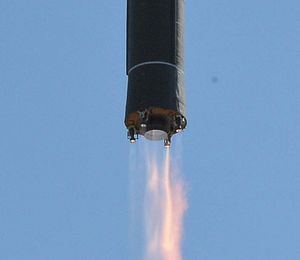The first stage of North Korea’s new intercontinental-range ballistic missile (ICBM), the Hwasong-14 (KN20), and intermediate range ballistic missile (IRBM), the Hwasong-12 (KN17), both use a variant of a Soviet-origin engine.
Specifically, both missiles, based on their observed flight tests, use a single-chambered variant of the Soviet-origin RD-250 family of liquid-propellant engines with 48 tons of thrust, according to current U.S. intelligence assessments. The engines make use of high-energy, storable hypergolic liquid propellants.
U.S. government sources with knowledge of the latest intelligence on North Korea’s ballistic missile and nuclear programs confirmed the assessment to The Diplomat, which supports part of an open-source finding released this week by Michael Elleman of the International Institute for Strategic Studies.
Elleman published a report outlining the RD-250-variant finding on Monday, in which he calculated a 48 ton thrust engine in both tests off publicly released imagery and video footage of North Korea’s recent launches. He additionally assessed that engines in both the new ICBM and IRBM belonged the RD-250 family.
North Korea first tested this liquid propulsion engine on March 18 this year; the engine was dubbed the “March 18 revolution” by Kim Jong-un. North Korean state media included an ominous warning that the “whole world will soon witness what eventful significance the great victory won today carries.” Weeks later, the first flight test attempts of the Hwasong-12 began out of Sinpo, culminating in the first successful flight-test of that system in May 2017.
While U.S. intelligence has assessed the design origins of the engine as belonging to the Soviet-origin RD-250 family, sources who spoke to The Diplomat said there is no confident U.S. assessment of the specific provenance of the engines in North Korea’s inventory today.
Notably, in contradiction with Elleman’s conclusions about the origins of these engines, which were covered in the New York Times earlier this week and in the Washington Post in July, the U.S. intelligence community does not currently assess that North Korea procured engines from the former Soviet Union. Neither Ukrainian nor Russian entities are currently assessed to have sold or transferred engines from the RD-250 family to North Korea.
To the contrary, The Diplomat has independently confirmed an assessment first reported by Reuters that parts of the U.S. intelligence community assess that North Korea likely has the capability to manufacture a liquid propulsion engine like the “March 18 revolution” indigenously.
While U.S. intelligence assesses that North Korea has the indigenous capability to manufacture engines like these, it has not assessed either way if it is already doing so or doing so independently. One source told The Diplomat that North Korea, if it did develop and manufacture this RD-250-variant engine indigenously, likely “codeveloped” the system with Iran.
Some evidence of Iranian involvement in North Korean ballistic missile engine development was apparent in 2016. In January that year, the U.S. Treasury Department sanctioned “11 individuals and entities” for their involvement in broader ballistic missile procurement for Iran.
The Treasury Department also noted in that announcement that “[w]ithin the past several years, Iranian missile technicians from SHIG (Shahid Hemmat Industrial Group) traveled to North Korea to work on an 80-ton rocket booster being developed by the North Korean government.”
In September 2016, North Korea carried out a static test of an engine that it claimed precisely exhibited an 80 ton force thrust. That engine has yet to be used in a North Korean ballistic missile, but was likely the engine built with Iranian assistance the January 2016 U.S. Treasury release referred to.
Whatever the origins of these new RD-250-variant liquid propulsion engines at the heart of the Hwasong-12 and the first stage of the Hwasong-14, according to sources who spoke to The Diplomat, there is currently no serious belief in the U.S. intelligence community that North Korea imported RD-250 units from either Ukraine or Russia.

































